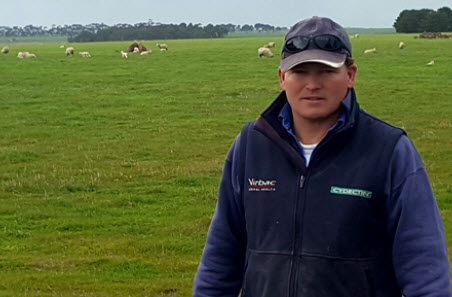Fencing for lamb survival
14 September 2017

The challenge of managing small mobs of multiple-bearing ewes to improve sheep productivity is faced by many mixed producers also dealing with paddocks designed for large-scale cropping.
Merino breeder Pat Millear, from Victoria's western district, pregnancy scans his 8,000 ewes then splits them into mobs based on pregnancy status to manage preferential feeding during winter and the lambing period.
Pat, who farms with his wife Sarah and four daughters, is part of a new MLA Producer Demonstration Site (PDS) project trialling temporary fencing to create smaller paddocks within existing fencing. This is to allow for smaller mobs and to spell other paddocks in preparation for lambing.
The three-year PDS project, with four demonstration sites, is being coordinated by local farming systems group, Willaura Best Wool Best Lamb (BWBL).
Size does matter
Livestock consultant Dr Steve Cotton, of Dynamic Ag Consultancy, is managing the PDS and said the 2017 demonstrations were measuring lamb birth weights, shelter and feed on offer (FOO) and would specifically assess mob sizes during lambing, with the aim of reducing mismothering.
“Usually mob size is governed by stocking rate and paddock size,” he said.
“But in a mixed cropping enterprise with larger paddocks (60ha or bigger), mob sizes for twin-bearing ewes can be up to 400 head. Current guidelines point to the benefits of mobs of 200 head or less."
Pat said Willaura BWBL wanted the PDS demonstrations set up on common local pasture types in typical paddock conditions to assess:
- easily erected, cost effective fencing options
- productivity increases.
The demonstration set up at the Millear property in July 2017 has the following treatments:
- 10 pregnant ewes/ha on 20ha areas rotated for a period of six weeks with FOO levels maintained at of 1.5–1.8t/ha
- eight pregnant ewes/ha on 20ha areas rotated for a period of six weeks with FOO levels maintained at 1.5–1.8t/ha
- eight pregnant ewes/ha on 20ha areas rotated for a period of six weeks with FOO levels maintained at 1.5–1.8t/ha (this paddock is fenced in half so 80 ewes are run on each side of the fence during lambing)
- six pregnant ewes/ha on 20ha areas rotated for a period of six weeks and FOO levels maintained at 1.5–1.8t/ha.
Pat said winter growing conditions had been favourable and regular monitoring of pasture growth had shown feed had increased during this winter.
Moving the boundaries
Steve said although some local producers were using semi-permanent fencing to split paddocks, research was needed on productivity and economic benefits of selecting paddocks and areas on the basis of shelter and aspect rather than convenience.
He said in some instances, semi-permanent fences were costing about $2/metre.
“Temporary fencing can be easily constructed and removed. It is a cost-effective way to split paddocks for improvements in pasture utilisation and to achieve smaller mob sizes for twin-bearing ewes, potentially reducing mismothering and improving marking rates,” Steve said.
“Also, mismothering accounts for close to 60% of all lamb mortalities in the paddock. This is well above the next biggest cause, dystocia, which accounts for just 17%.
“Across Australian sheep flocks, it is estimated about 80% of mortalities occur within the first three days of the lamb’s life.”
Matching ewe requirements to pastures
The Millear family pregnancy scan in early June to prepare for mid-August lambing and the selling of wether progeny within 12 months.
Grazing on the 6,500ha property, which receives 500mm of annual rainfall, is on annual sub-clover and ryegrass and perennial phalaris-based pastures. Grazing winter wheat varieties help fill feed gaps in the colder months.
Across all mixed-aged ewes, average ‘scanned-in-lamb’ results were 145%, with maiden ewes typically achieving 96%, after two rounds of joining. Marking and weaning rates sit at about 96% for single bearing ewes.
Once scanned, ewes are split into mobs of singles, twins and triplets for feeding management.
“Using temporary electric fencing, we split paddocks up into 20–25ha to run mobs of 150–200 head," Pat said.
“The aim is to get to a stocking rate of about 10 dry sheep equivalent (DSE) per hectare.
“Rotations are made based on FOO levels, with the aim to maintain pregnant twin-bearing ewes at condition score 3.5 and single-bearing ewes at condition score 3.
Pat said the flock average stocking rate was now about 6–8 DSE (less for maiden ewes), which was a big increase from 10 years ago when it was 4 DSE/ha.
When shifting to this more intensive grazing system, Pat said there were challenges in setting up and maintaining temporary electric fencing and ensuring it contained the stock.
“It is an intensive system, as we need to check the ewes every day, but it is beneficial,” he said.
“Another benefit is that there are more paddock areas not being grazed in mid to late winter, meaning they can build up FOO levels ready for ewes at lambing.”
Boosting productivity one region at a time
MLA General Manager – Producer Consultation and Adoption, Michael Crowley, said the PDS program was designed to provide farming systems groups, such as Willaura BWBL, with capacity to evaluate locally-specific tactics to optimise feedbases and boost livestock production.
“Establishing these sites helps producers to see the benefits and practical application of new technologies and instigation of innovative management ideas relevant to their production system and location.”
Information:
Pat Millear
E: millearaps@bigpond.com
Steve Cotton
T: 0447 352 321
E: s.cotton@dynamicag.com.au
Want to get involved?
MLA Producer Demonstration Sites: mla.com.au/pds


